Packaging and Packaging Waste Regulation (PPWR) – Business Guidance
Topics
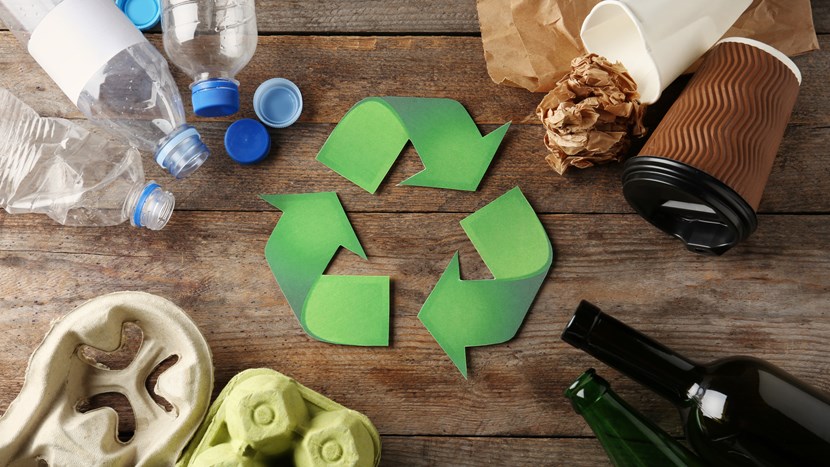
The EU Packaging and Packaging Waste Regulation (PPWR) introduces a comprehensive reform of how packaging must be designed, labelled, reused and recycled across the EU. It aims to reduce packaging waste, increase the use of recycled materials and promote circularity in packaging systems.
For UK food and drink manufacturers, the PPWR will be relevant to any business exporting to the EU or supplying the Northern Ireland market. Under the Windsor Framework, most PPWR provisions apply in Northern Ireland, creating a dual regulatory landscape for UK producers operating across different markets.
Purpose of the Guidance
This guidance has been prepared to help UK manufacturers understand the implications of the PPWR and how it interacts with existing UK packaging legislation, including:
- Extended Producer Responsibility (EPR)
- Plastic Packaging Tax (PPT)
- Consistent Collections
It provides a comparison between PPWR and UK regulations, highlighting areas of alignment and difference across implementation timelines, obligations, and compliance requirements. The aim is to support members in assessing potential impacts on packaging, operations, and supply chains. This guidance includes dedicated sections on:
- Substances of Concern
- Producer Obligations
- Recyclable Packaging
- Minimum Recycled Content in Plastic Packaging
- Compostable Packaging
- Excessive Packaging & Minimisation
- Reusable Packaging & Refill
- Labelling Requirements
- Restrictions on Certain Packaging Formats
- Prevention of Packaging Waste
- Separate Collections
- Recycling Targets
Why PPWR Matters
While the UK and EU share the same goal of reducing packaging waste, PPWR introduces harmonised obligations that go further than current UK requirements. Including:
- Mandatory recyclability for all packaging by 2030
- Minimum recycled content thresholds for plastic packaging
- Reuse and refill targets for specified packaging types
- Restrictions on certain single-use formats and excessive packaging
- A harmonised labelling system to support effective sorting and recycling
These measures will have significant implications for packaging design, material choice and cost structures across the food and drink supply chain. Early understanding will help businesses prepare and manage compliance risks.
Businesses selling food and drink products into the EU must comply with the new Packaging and Packaging Waste Regulation (PPWR), which sets out the requirements packaging placed on the EU market must fulfil including on recyclability, recycled content, reuse and labelling . Due to the Windsor Framework, most of these requirements also apply to packaging placed on the Northern Ireland market as outlined in the Commission’s explanatory memorandum accompanying Regulation (EU) 2025/40.
Key Areas of the PPWR and UK Comparisons
Substances of Concern (PPWR Article 5)
- Lead, cadmium, mercury, and hexavalent chromium: For PPWR, the total concentration of these substances in packaging must not exceed 100 ppm. In the UK, the same limit is established under The Packaging (Essential Requirements) Regulations 2015 (SI 2015 No. 1640).
- PFAS: Within PPWR, food contact packaging containing intentionally added PFAS above defined thresholds will be banned by 12 August 2026. In the UK, whilst packaging containing PFAS is regulated under REACH Regulation (EC) No. 1907/2006, there are currently no plans to implement a ban on packaging containing intentionally added PFAs.
Producer Obligations (PPWR Article 5 to 11)
Packaging manufacturers may only place packaging on the EU market if it complies with the requirements outlined in Articles 5 to 11 of the PPWR. They must also retain technical documentation demonstrating this compliance — for five years after placing single-use packaging on the market, and for ten years in the case of reusable packaging.
In the UK, the Packaging (Essential Requirements) Regulations 2015, require that producers ensure all packaging placed on the market must be of a minimum volume and weight and must be the minimum amount to maintain the necessary levels of safety, hygiene and acceptance for the packed product and for the consumer. Packaging must also meet essential requirements for safety and functionality and be manufactured so as to permit its reuse or recovery as well as meet heavy metal limits. Producers must also keep documentation demonstrating compliance for up to four years.
Recyclable Packaging (PPWR Article 6)
- From 1 January 2030, all packaging placed on the EU market must be recyclable, with limited exceptions (e.g. for certain medical or safety-critical uses).
- Recyclability will be categorised into three grades (A, B, or C), with detailed criteria to be set in implementing acts which must be adopted no later than 1 January 2028 (PPWR Art. 6.4). These grades will determine how EPR fees are modulated.
- From July 2029 (18 months after adoption of the delegated act required by January 2028, in line with PPWR Art. 6.8), EPR fees must be modulated based on the recyclability grade of packaging. At the same time as establishing the detailed design for recycling criteria the EC will adopt (via Implementing Acts) harmonised modulation criteria based on the recyclability performance grade whilst leaving MSs to set their own fee rates.
- Eco-modulation may also take into account additional factors such as the use of recycled content and the presence of hazardous substances.
- From 1 January 2035, packaging must not only be recyclable in theory but also recycled at scale. This means that sufficient collection, sorting, and recycling infrastructure must be in place across the EU for that type of packaging.
- From 1 January 2038, only packaging with a recyclability grade of A or B will be allowed on the EU market. Packaging graded as C will no longer be permitted.
Comparing both the EU and the UK EPR schemes, there are notable differences in their approaches to recyclability assessment and fee modulation. The PPWR will use a grading system to assess recyclability based on a “design for recycling” approach (2030) eventually only permitting grades A and B on the market (2038). The UK’s EPR system assesses recyclability using the Recyclability Assessment Methodology (RAM) tool which assesses performance throughout the recycling process based on current infrastructure provision. Unlike the EU, the UK does not plan to ban any specific packaging formats based on recyclability. However, producers using harder-to-recycle packaging are expected to face significantly higher EPR fees.
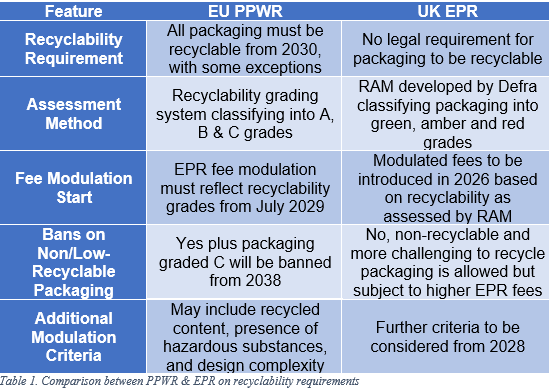
Minimum Recycled Content in Plastic Packaging (PPWR, Article 7)
Subject to specific exemptions, any plastic component of packaging placed on the EU market must contain a minimum percentage of recycled content derived from post-consumer plastic waste. These minimum requirements are set by packaging type and format, with binding targets for 2030 and 2040 (see Table 2 below). Recycled content will be calculated as an average per manufacturing plant and calendar year.
The recycled content requirements do not apply in the following cases:
- Food-contact plastic packaging, where the inclusion of recycled content would pose a risk to human health and cause the packaging to breach Regulation (EC) No 1935/2004 on materials and articles intended to come into contact with food.
- Compostable plastic packaging.
- Contact-sensitive plastic packaging used for:
- Infant formula and follow-on formula,
- Processed cereal-based food,
- Baby food,
- Food for special medical purposes.
- Any plastic part that represents less than 5% of the total weight of the packaging unit.
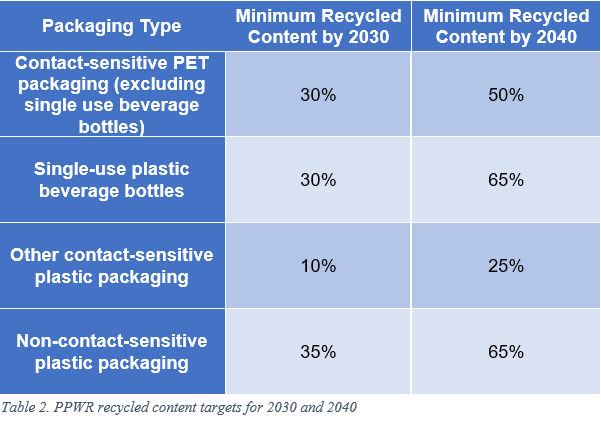
The Commission must adopt implementing acts by 31 December 2026 to establish a unified methodology for assessing, verifying, and certifying recycled content from post-consumer plastic waste, including material sourced or processed outside the EU.
From 1 January 2029, all affected plastic packaging must comply with the adopted methodology for calculating and reporting recycled content.
In contrast, the UK Plastic Packaging Tax (PPT) imposes a flat-rate tax on plastic packaging that contains less than 30% recycled content, regardless of type or use. Unlike PPWR, PPT does not set future targets, ban non-compliant packaging or make allowances for the constraints imposed by food contact materials legislation. While both frameworks aim to increase recycled plastic use, the EU uses a regulatory compliance model, whereas the UK takes a fiscal approach to drive change.
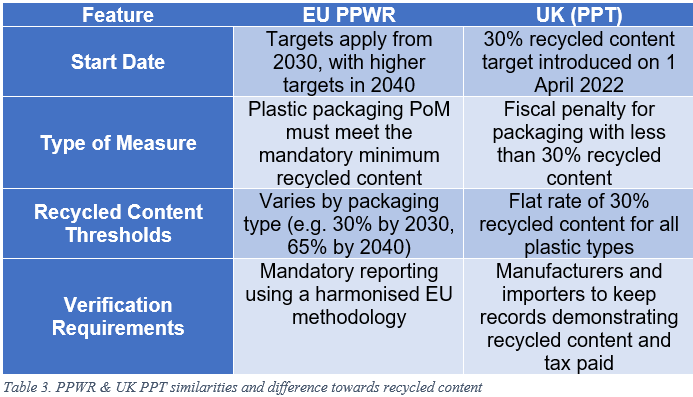
Compostable Packaging (PPWR Article 9)
By February 2026, the European Commission must request the European standardisation organisations to update harmonised standards for compostable and home-compostable packaging. From 2030, specific packaging types, including tea bags, filter coffee pods, and PLU labels on fruit and vegetables, must comply with the standards for industrial composting and home composting standards.
Until mid-2026, Member States may add other packaging formats to the list of items that must be compostable, based on national conditions. However, unless compostability is explicitly required under PPWR or through a national derogation, packaging must be recyclable and must not hinder the recyclability of other waste streams even if made from biodegradable or compostable materials.
In contrast, the UK EPR scheme currently does not mandate compostability for any packaging type and treats compostable packaging as non-recyclable and therefore it will be subject to higher EPR fees. NB Under UK EPR legislation tea bags and coffee pods where the coffee is discarded with the capsule are not considered packaging
Excessive Packaging & Minimisation (PPWR Article 10 & 24)
By 1st January 2030, packaging placed on the EU market must be designed in such a way that its weight and volume are limited to the minimum necessary to ensure its functionality, including protection, hygiene, safety, characteristics of reusable packaging and provision of information to consumers. Use of packaging features that are considered misleading, such as double walls, false bottoms or other design elements that artificially increase the perceived volume of a product will also be prohibited. By 12th February 2027, the Commission must request the European standardisation organisations to prepare harmonised standards and assessment methodologies for packaging minimisation to ensure consistent enforcement across Member States.
By 1 January 2030, or three years after implementing acts take effect (whichever is later), grouped, transport, and e-commerce packaging may contain no more than 50% empty space. By 12 February 2028, the Commission will define the calculation method for this, taking into account safety, product protection, or legal requirements. From 12 February 2028, sales packaging must also minimise empty space while maintaining functionality. Exceptions apply for products that settle during transport or require headspace as well as to sales packaging used directly as e-commerce packaging and to reusable packaging within reuse systems. By 12 February 2032, the Commission will review the 50% limit and exemptions; it will then consider setting specific ratios for certain products.
The UK, the Packaging (Essential Requirements) Regulations 2015, contain a similar general requirement that producers ensure all packaging placed on the market must be of a minimum volume and weight, must be the minimum amount to maintain the necessary levels of safety, hygiene but with the additional consideration of maintaining consumer acceptance for the packed product. EPR will also apply fees based on the weight of the packaging such that excessive packaging will attract higher compliance costs.
Reusable Packaging & Refill (PPWR Article 11 & 29)
PPWR sets out specific conditions under which packaging may be classified as reusable. To qualify, packaging must be designed and marketed to be reused multiple times without losing its intended function. By February 2027, the EC must establish the minimum number of rotations required for packaging to be considered reusable. PPWR sets binding reuse targets for certain packaging types, with phased obligations from 2030 to 2040 requiring producers to meet minimum percentages of reusable packaging.
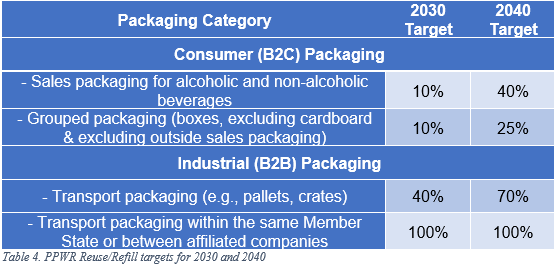
Additionally, from 1 January 2030, final distributors with a sales area exceeding 400 m² are required to allocate at least 10% of their sales area to refill stations, covering both food and non-food products.
For now, the UK EPR system does not include binding reuse targets or minimum rotation requirements although Defra is expected to launch a call for evidence later in 2025 to explore ways to support and incentivise reusable packaging, focusing initially on glass. This step aims to gather stakeholder input to inform future policies that promote reuse and advance the UK’s circular economy.
Labelling Requirements (PPWR Article 12)
By August 2026, the European Commission must adopt an implementing act establishing a harmonised packaging label, including a standard pictogram and detailed labelling specifications. In June 2025, the Joint Research Commission (JRC) conducted a targeted consultation on a proposed system of Waste Sorting Labels (WSL), which would direct consumers to dispose of packaging using correspondingly labelled waste bins. Feedback from this consultation is awaited.
In contrast under the UK EPR Scheme labelling requirements have been temporarily removed pending a review of the scope for alignment with the EU PPWR framework with the aim of reducing complexity for businesses.
Restrictions on certain Packaging Formats (PPWR Article 25)
From 1 January 2030, economic operators will be prohibited from placing the following packaging formats on the EU market:
- Single-use plastic grouped packaging (e.g., collation films or shrink wraps) used at the point of sale to bundle bottles, cans, tins, pots, tubs, or packets intended as convenience packaging to encourage or enable consumers to purchase multiple products. This restriction does not apply to grouped packaging necessary for handling or logistics.
- Single-use plastic packaging for pre-packed unprocessed fresh fruit and vegetables weighing less than 1.5 kg.
- Single-use plastic packaging, such as sachets, containing individual portions or servings of condiments, preserves, sauces, coffee creamer, sugar, and seasoning.
No such prohibitions have been legislated or are currently planned in the UK. However, under the current UK Plastics Pact there are voluntary targets for producers to eliminate problematic and unnecessary packaging which cover some of these items.
Prevention of Packaging waste (PPWR Article 43)
PPWR sets binding targets for reducing per capita packaging waste compared to 2018 levels: 5% by 2030, 10% by 2035, and 15% by 2040. By 12th February 2027 correction factors will be established to account for tourism. Until 31st December 2025, Member States may request an alternative base year if justified by reporting changes rather than consumption trends. By 12th February 2032, the Commission will review progress and consider introducing material-specific targets, accompanied, if necessary, by new legislative proposals.
Member States are required to implement additional waste-prevention measures, such as extended producer responsibility schemes or require producers to implement waste-prevention plans, provided they are proportionate, non-discriminatory, and do not distort trade. They must also encourage the provision of tap water in reusable or refillable formats for free or a small service fee in hospitality settings.
No prevention targets are currently established under UK legislation.
Separate Collections (PPWR Article 48 & 49)
PPWR requires Member States to set up systems for the return and separate collection of all packaging waste. These systems must support reuse and enable high-quality recycling. Packaging that meets design-for-recycling standards must be collected for recycling and cannot be sent to landfill or incineration, except for residues left after treatment when recycling is not technically or environmentally beneficial.
Member States must ensure nationwide collection and sorting systems that preserve the quality of recycled materials. In limited cases, mixed collection may be allowed if it achieves comparable results, but packaging collected in this way may still need to be sorted before disposal or energy recovery.
These systems must cover all packaging types and provide accessible facilities in public, commercial, and residential areas. They must be open to all operators and authorities, treat imported products fairly, and avoid distorting trade. Member States are also required to promote recycling that meets quality standards. From 1 January 2029, Member States must set mandatory collection targets aligned with PPWR recycling targets.
By contrast, the UK’s consistent collections policy is being taken forward separately in each of the four nations. The broad objective is for local authorities and businesses to collect paper and card, plastic, metal, glass (along with food and garden waste) nationwide by 31 March 2026, with plastic films and flexibles added by 31 March 2027.
In England, under a policy branded ‘Simpler Recycling’, packaging materials may be co collected except for paper and card (unless a separate assessment is made to demonstrate that this is either not technically or economically practicable or has no significant environmental benefit). Unlike the PPWR, the policy does not ban landfill or incineration of recyclable packaging. In addition, as of October 2024, waste facilities in England must follow new rules for sampling, measuring, and reporting the types and amounts of waste they handle. These requirements aim to improve the quality of recyclable materials and ensure better data for recycling systems. Facilities must notify the Environment Agency, carry out regular sampling, and submit their waste data in the specified format.
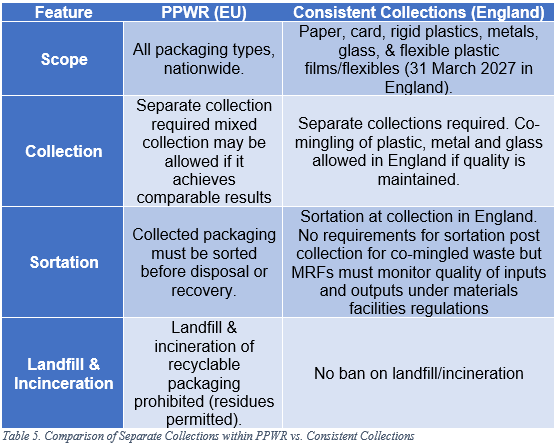
Recycling Targets (PPWR Article 52)
PPWR sets binding recycling targets for packaging waste. By 31st December 2025, Member States must take measures to achieve the below recycling rates in table 6.
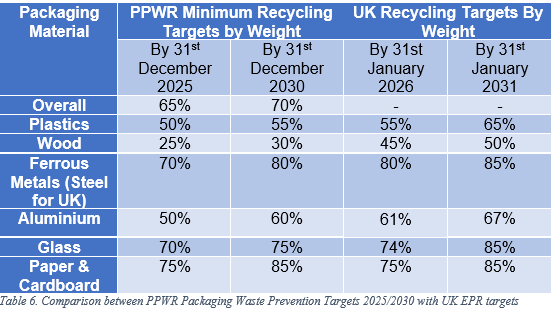
Member States may postpone the material-specific targets by up to five years, provided that:
- Any derogation from the target may not exceed 15% when applied to a single target or divided between two targets.
- Recycling rates for any material must not fall below 30% after 31 December 2025.
- Recycling rates for glass, paper, and cardboard must not fall below 60% after 31 December 2025, or 70% after 31 December 2030.
- The derogation must be supported by an implementation plan submitted to the Commission no later than two years before the relevant deadline.
By 12 February 2032, the Commission will review the 2030 targets with a view to increasing them or setting additional goals.
